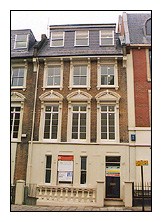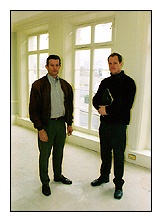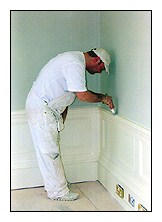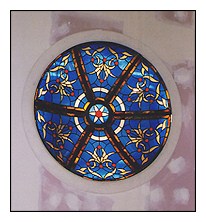 |
 |
taken
from BTi Magazine, March 2001 issue,
photographs reproduced courtesy of BTi.
On an approach road to
Windsor Castle, a four-storey Georgian building is
having a makeover courtesy of architect Edington Spink
and Hyne. Number 6 Sheet Street, called Kingsbury House,
will soon be ready for its new occupants, who it is
hoped, will take kindly to the Georgian theme that the
architect is trying to create.
|
|
"We
are taking a classical concept and making it work with
all the needs of a modern building," says Mark
Curzon, project architect.
Works to the front façade
have been carried out to match those depicted in old
photographs. Inside, Time Construction is carrying out
the majority of the works using plenty of timber.
At first
sight it appears the timber skirting, cornices and
columns are simply there to continue the Georgian theme.
Admittedly they are, but they also conceal the wires
that will power, light and feed data to the building.
The only visible evidence of this will be the outlet
points at designated spaces. |

External works have been carried out to the facade. (click
the picture above for a enlarged view)
|
Hiding behind the skirting boards
is a system called three compartment trunking. Basically it is
three rows that run parallel to the skirting board separated into
compartments, each compartment holding a different cable. From the
top down, the cables are for data, power and telephones.
"Getting all the services in has been difficult, but
surmountable," says Richard Croxford, managing director of
Time Construction.
|

Richard Croxford, MD at Time Construction (above left),
next to project architect Mark Curzon on the first floor.
|
For future maintenance to
the cables, carpenters from Time have carefully blended in
access panels at set locations. Vertical involvement of
cables is concealed in columns. On each 70sq m floor it
appears no stone was left unturned. "Everything was
in poor condition. We had to rip everything out until we
were just left basically with the floor joists," says
Mr Curzon. To create as much headroom and space as
possible, each floor was moved upwards by as much as
700mm. As a result everything connected to the flooring
needed altering.
Most
disturbed by the floor movement was the buildings'
plumbing, all of it has been replaced or reworked
including the repositioning of radiators, an additional
boiler, and bathrooms on each floor are being renovated
and connected. Lighting comes in the form of 30 category 2
lights on each floor, all fitted with fire hoods and
bedded to be flush with the ceiling. The ceilings are made
of a double layer of fire-lined plasterboard for further
protection.
|
|
The original
internal doors varied in size by up to 3m in height. Time
Construction has brought all internal doorways to the same
size and will fit 20 Windsor style doors in their place.
It is the first time
that Edgington Spink & Hyne (ES&H) of Datchet, Berkshire,
has worked with Heathrow firm Time Construction. On this contract
ES&H has taken on the role of project manager as well as
architect. Time Construction has carried out the majority of the
work in the £500,000 total value contract, of which £10,000 has
been used solely for improvements to the lift. The ropes have been
replaced, buttons renewed and the internals decorated.
Colours of
paint and carpets have been selected to fit the Georgian
style. Skirting and cornices will be painted in a barley
white eggshell with the remainder of the walls coated in a
off-white called Palladium 12. Terracotta coloured carpets
will grace the public areas and blue lagoon carpets will be
in private areas.
|

A decorator delicately applies paint to timber.
|
As it is close
to the castle, the windows have to remain due to a
conservation order. Planning permission had to be granted to
add air conditioning to the roof that now supplies wall
mounted outlets on each floor. There will also be six plasma
screens for displays, satellite television and DVDs.
Edington Spink &
Hyne started the design work in July last year, with work starting
in October. It is due for completion this month, after which the
new tenant a recruitment consultancy will move in.
|
Thomas Edgington was
born in 1820 and moved to Windsor in 1852. He set up his
architecture practice in Windsor in 1856, and carried out work at
Windsor Castle. The firm claims it is the oldest established
architecture practice in the UK. In 1907, Herbert Spink joined and
was followed in 1955 by Reginald Hyne. Two years ago the company
moved into project management as well as architecture.
Now based in
Datchet,
Berkshire it has 15 praticising architects and five partners.
Primarily it covers the south east of England, with work ranging
from new build to refurbishment. East Berkshire contains many
examples of brick buildings that were built in the 1920s and 30s
to Edgington Spink & Hyne designs.
|

A glass dome has been added over a skylight

|
|
|